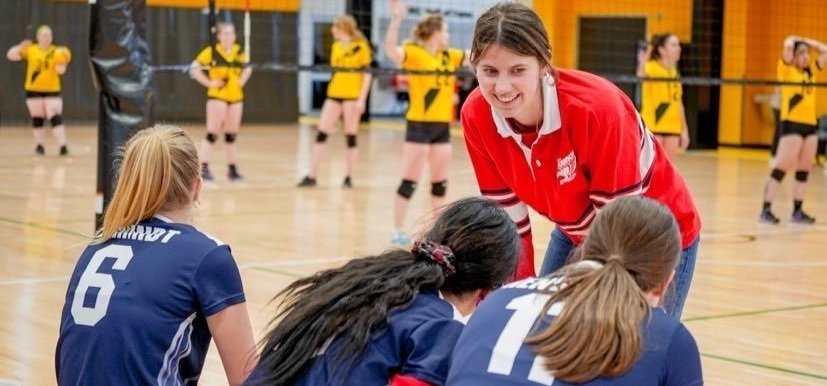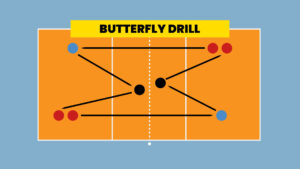Table of Contents
Starting a volleyball club can be an exciting and rewarding venture, but it also comes with its fair share of challenges. Whether you’re looking to create a competitive team or simply foster a love for the sport among younger players, establishing a volleyball club requires careful planning and organization from the outset.
To successfully launch your volleyball club, you’ll need to assemble a dedicated core team, establish the club’s identity, handle legal and financial matters, and build an online presence. This step-by-step guide will walk you through the key considerations for how to start a volleyball club, ensuring you lay a solid foundation for long-term success while navigating the initial hurdles.
Assemble a Core Team

Success starts at the top with a dedicated team of individuals whose talents and ideas contribute to the volleyball club’s goals. Recruit people to share your mission and vision who bring diverse skills and experience to the group. Encompass volleyball and business expertise such as coaching, recruiting, marketing, finance, and administration.
Recruit coaches and volunteers
Qualified and experienced coaches are a key component of your club’s future as, oftentimes, good players will follow good coaches. Incorporate all volunteer opportunities on registrations, websites, posters, and emails, especially an option for an assistant coach. Emphasize the resources your league will offer to these volunteers (especially ones who have never coached before), such as coaching clinics, online videos, and practice plans to make their job easier.
Many parents or caregivers coach only while their children are involved in the club. Through your registration process, you should still have the email addresses and phone numbers of these parents; don’t hesitate to get in touch with them and see if they are interested in returning. Similarly, if your league has been established for many years, it will have many former players who fondly remember their time on the field, court, or ice. These alums may not have kids of their own but are willing to be head or assistant coaches.
College campuses may provide a good pool of candidates that kids can relate to on a different level than they would with parent coaches. Check with local college teams, student union clubs, and Greek life organizations. In many cases, college students are seeking volunteer opportunities for their resume or to enhance a career aspiration. Consider designating older students as assistant coaches if you don’t think they are ready for the entire responsibility.
Every school has an administrator who is in charge of their sports programs. Most high schools will have someone with the title of athletic director. Elementary or middle schools will likely have the principal or an assistant principal in charge of this. When in doubt call the school and ask the person who answers the phone who is in charge of the sports programs. Contact that person and express your interest. They will probably ask you some questions about your experience and then they will likely set up a meeting between you and the coach. If the coach thinks you could be useful they will move forward in getting your background checked.
Define roles and responsibilities
Establish clear roles and responsibilities to foster a collaborative and supportive work environment. As you expect teamwork on the volleyball court, you expect it at your club’s leadership level. Support the volleyball program to the best of your ability. Positively support your daughter’s efforts, as well as the efforts of her teammates. Don’t criticize coaches or another player to a third party. Seek to understand, not to judge.
If after careful consideration, you have a valid complaint that your daughter cannot handle, speak directly to the coach in a mature and respectful manner. If the coach cannot resolve a problem, contact the Club Owner. Support the volleyball program and policies to the best of your ability. Help set individual and team goals, setting aside time to discuss them.
Establish shared goals and vision
Clearly communicate each player’s role on the team. Treat players with respect, maturity, and understanding. Listen to all player concerns with an open mind. Encourage the players to play to the best of their ability. Act in a mature manner when dealing with other teams, coaches, referees, adults, etc. Have fun and show the players/parents how much fun volleyball can be.
Teams have been selected. Typically the next priorities are preparing for preseason matches, determining a starting lineup, and implementing your training plan. All of these are important, but you should also consider your season-long goals. In your season-long perspective – what is a realistic goal for each team in your program? How do you develop and implement a plan that gives each team the best opportunity to be successful and peak at the right time?
For each team, it is imperative the group has a common vision and goal (a realistic one, please). For a coach to push a team to reach new successes, the team must embrace the goal and a great way to achieve this is to involve your players in setting the goals. Spend time over a couple of days introducing and finalizing the team goals. On the first day – usually at the end of practice – our teams would discuss our approach to goal setting. We then asked the team members to be prepared the next day to share their thoughts and come to a consensus. The next day – prior to practice – we would spend 15 to 30 minutes sharing thoughts and agreeing on one or more goals.
Be sure to revisit these goals as your team progresses through the season. This provides validation for the process and ensures everyone receives feedback. Note: This activity provides a great opportunity to allow your older players to practice leadership skills by taking a key role in the discussion. There are inherent long-term benefits for the program and team by promoting this leadership structure and empowering your athletes.
Establish the Club’s Identity

Choose a unique name
Choosing the name of your volleyball club can be very important to attracting future players and standing out. You do not want to pick a name every other club has, so avoid the non-unique names like “Spike” or “Revolution” that are very common in the US. By coming up with unique names, your club will also be easier to search and find. You can do this by including the name of your city or coming up with a clever name on your own.
Coming up with a creative and unique name for your club will help your website and social media accounts. This will help you come up with a unique domain name that is easily searchable on Google, Facebook, and Instagram. If you’re looking for inspiration, consider names like “Aces”, “Air Traffic Control”, “Block Party”, “Diggin’ Divas”, “Net Ninjas”, “Serving Sirens”, “Spike Tysons”, or “Volley Vibes”.
Design a logo and branding
An important part of your social media accounts that can be marketed to draw people in is your brand image. The logo for your club can be very important in being the recognizable image on all your accounts. In sports, everyone knows every team by their logo, so try to do the same with your club. Make a great logo and color scheme that is attractive to players and will be usable for years to come.
Building credibility for your organization is important for managing a youth sports program. Your logo makes the first impression. To create a sports logo, start by brainstorming ideas, researching examples, and considering fonts you like. You can use AI tools to generate some quick logo ideas or recruit a local volunteer designer to help. If you have a limited budget, find a professional designer online or use an online logo maker. A high-quality logo can be created for around $100.
Set up social media accounts
Most coaches would agree that times have changed with the introduction of social media and apps into the sports world. While some coaches view social media as a hindrance that distracts athletes, it can also be a positive tool for motivation and team-building if used correctly. Not only is social media helpful for motivating athletes and building team unity, but it is also a great tool to assist with the mental aspect of the sport by posting articles and videos about team leadership, mental adversity, and working hard.
To keep your team’s social media experience safe, positive, and productive, check with your institution’s social media/internet safety policy to ensure compliance. For youth programs, develop a social media/internet safety policy and share it with players’ parents and legal guardians, obtaining their consent. Well-organized social media pages with consistent branding can help your organization build credibility in your community.
Handle Legal and Financial Matters

Register as a business or non-profit
When starting a volleyball club, you need to register your business with the IRS. If you’ll be the sole person responsible for the club initially, you will likely be a Sole Proprietorship in the eyes of the IRS, which is quick to set up, and you’ll use your personal information and be personally responsible for taxes on any profits.
Alternatively, you can register as a Limited Liability Company (LLC). The advantages of this format are that profits and losses can be passed through to owners without taxation of the business itself while shielding the owners from personal liability. An LLC requires obtaining a Federal Employer Identification Number by filing form SS-4 with the IRS.
If you expect to run the club as a non-profit, you’ll want to register as a 501(c)(3) organization, which is deemed a charitable organization by the government and is not required to pay federal taxes on earnings. To obtain 501(c)(3) status, you must file IRS form 1023 and include specific language in your Articles of Incorporation and By-Laws.
Open a dedicated bank account
Once you’ve named your club and set up your LLC or 501(c)(3), you should open a separate bank account specifically for the club, even if you’re starting small. This has several advantages, such as separating club funds from personal finances, issuing and cashing checks in the club’s name, easing officer transitions, ensuring transparency of fund usage, and complying with tax reporting requirements.
Create a budget and pricing structure
Budgeting is crucial as it provides a roadmap for your club’s financial needs and growth. For an existing club, you can refer to past accounting reports and data, but for a new club, you’ll need to make educated estimates based on anticipated athlete numbers, camps, lessons, and fixed costs like rent, insurance, staff equipment, and variable costs like tournaments, travel, uniforms, and coaches.
It’s essential to start each year with a “Base” budget for each team level (Premier, National, Boys, Semi-National, Regional, etc.), including practice costs, administrative costs, and other fixed costs. Then, create individual team budgets by factoring in variable costs like travel expenses, coaches’ pay, hotel costs, food costs, and tournament entry fees.
Be prepared to adjust your budget and travel schedules until the start of the season when player contracts are signed. After that, you can focus on training the athletes.
Build an Online Presence

Develop a website
Whether you’re establishing a new organization or you’ve had an online presence for years, starting to build a club volleyball website in advance of the season is a huge step to getting your season off on the right foot. Your club’s website must be easy to access from any device, that parents and players can find you on Google, and you set up convenient payment options for parents and players.
Your website should be the hub for promoting your club. Remember that a lot of people who visit your website won’t know anything about the club, so be sure to list and update all of your basic information:
- The year your club was founded – build some credibility with people who are new to the club
- Mission and Values of the club – make sure everyone knows what you’re all about
- Accomplishments (team and individual) – pat your club on the back!
- College signings – competitive players care about your success in getting players to the next level.
- Staff bios – parents and players will want to get to know you before signing up for events or tryouts. There’s no better place to promote your staff than on your website. Why is your staff qualified to coach and train players?
Updated, professional websites are more likely to build trust with current and potential members than poorly designed or outdated ones. Also, a properly updated website allows everyone to find vital information without needing to email or call with a question. What are the top questions you receive about your club? Whatever they are, the answers should be easy to find on your website. It doesn’t necessarily have to be on your home page, but your navigation should be such that anyone can quickly guess where to find the answer.
Where are you located? What’s your phone number? Adding your contact information to the footer of your website allows people to quickly reach out. While your website is important, it’s likely social media is where you routinely share updated information, photos, and stories. Place your social media icons on your home page, or better yet, in a universal header or footer so your fans can follow.
Is your site mobile-friendly? Have you looked at it on your phone lately? In 2019, 52% of website traffic came from mobile phones, and that number will only increase. For the USA Volleyball website, 59% of traffic in 2019 was mobile. Most low-cost web services have mobile readiness built in, so if it’s time to update your website, always think about mobile first.
Web accessibility supports inclusion for people with disabilities. There are simple steps you can take to improve the accessibility of your site, and doing so opens your website to a valuable audience segment. For instance, use alt text for all images, limit your use of color in certain instances, and use headings where appropriate. Not only do alt tags, headings, and other improvements open your website to different populations, but they also make your website friendlier to search engines. This will help your club’s site appear higher in search engine results.
You have a lot on your plate as a club director, and sometimes updating the website is the last thing on your mind. Try setting a weekly time to briefly go through your website and update items where possible. Visitors to your site will notice that you are doing your best to provide the most accurate information.
Enable online registration and payments
Convenient payment options are critical to make parents happy and to save yourself time as a coach or administrator. If you’re still primarily collecting cash and checks, you should consider setting up payments online for your tryouts, clinics, camps, and season fees right away. It’s simple to set up online forms to allow participants to pay online using a debit or credit card. Funds get deposited straight into your bank account so you don’t have to chase down payments or make trips to the bank.
For higher payment amounts like your club dues for the season, make sure you offer flexible options for parents to pay. An initial deposit, followed by several payment due dates can give parents an easy way to pay their full season fees without paying up front all at once. Setting up a payment plan option gives parents a convenient way to pay in installments, and also guarantees that your club will get your money on time. Parents will expect that there are easy ways to pay and to have a credit card option available. The good news is it’s easier than ever to collect payments online for your volleyball club. Don’t leave this out when you set up your website for your next season!
If you want to offer online registration, you’ll need sports registration software. The right solution can help streamline the registration and payment process, making things easier for your league managers and parents alike. Sports registration software is a type of online tool that enables processes like team registration and league management. With the right registration tool, your sports league can manage tasks like:
- Registering players online
- Accepting online payments
- Getting waivers and acknowledgments e-signed
- Collecting required documents
Essentially, the entire registration process can be moved online so that you’re able to accept registrations anytime—and not just during in-person registration events. Plus, all paperwork is now handled electronically, eliminating the need for piles of paperwork and endless trips to the bank.
Parents can register whenever they want. They don’t have to show up in a limited window at the designated location. They can register when they have a few minutes from their couch. That way, you can register more players and make the experience better for your participants. And after adding their player’s information, parents can pay right there online. Your organization can offer payment plans and accept various payment methods, which is much better than having people go to the bank and deposit a check.
Gone are the days of chasing down payments and organizing paper signups with hand-written notes. SportsEngine HQ moves the entire registration process online to save you time and effort. Collect information, run reports, offer payment plans, and securely process money—all online with SportsEngine HQ. Get all the information you need on an individual without lifting a finger. Data is securely transferred right from an online form into your member directory.
Securely collect birth certificates, waivers, payments, codes of conduct, and detailed information on every athlete, guardian, and coach all on the same form. Registration is the kickoff of your members’ journey. Data is imported, rosters are made, and apps are unlocked. Plus, provides insurance, recruiting services, abuse prevention training, and more directly to families during registration. Work gets done on the go. Our registration forms are mobile-friendly, meaning families can provide information and make payments from anywhere. Create custom payment terms to work within family budgets and allow them to quickly select an option that fits their needs.
Promote the Club Through Digital Marketing

A good website is very important for any volleyball club. First, make sure the website looks nice and is easy to use. Use clear pictures and graphics to show what the club does. The website should let visitors interact with the club. It should have information about the club’s history, mission, and goals. List the programs and services offered. Add features for online sign-ups for events and training. Also, make sure the website is easy to find on search engines.
To build a strong community on social media, create profiles on Facebook, Twitter, and Instagram. Make sure these profiles look good and are easy to find. Use clear pictures and videos. Write interesting posts using simple words. Respond quickly to comments and messages. Using social media to share news, promote events, and offer special deals. Use tools to see which posts get the most likes and comments. Use this information to make better posts in the future.
To promote club membership with Facebook and Instagram ads, create eye-catching ads. Use clear pictures and videos and include a clear call-to-action, like “Join Now” or “Learn More.” Target your ads to specific groups of people based on their age, gender, location, and interests. Track how well your ads are doing to see which ones work best.
If your website does not bring in new members, improve your Search Engine Optimization (SEO). SEO helps your website show up in search results. Use keywords in titles, URLs, and content. Tools like Moz and Wordtracker can help find the best keywords. Write new content regularly, like blogs about volleyball tips and training. This helps with SEO and shows your club’s knowledge.
Writing white papers can also help. These are detailed guides that show your expertise in volleyball. Share these on your website and LinkedIn. For better search engine placement, use digital ads. Google AdWords lets you “buy” keywords to appear at the top of search results. Google offers training on this through its Academy for Ads.
Conclusion
Starting a successful volleyball club requires careful planning, organization, and a dedicated team effort. Each step plays a crucial role in laying a solid foundation for long-term success, from assembling a core group of coaches and volunteers to establishing the club’s identity, handling legal and financial matters, and building an online presence. By following the outlined steps, you can navigate the initial hurdles and create an environment that fosters the growth and development of young volleyball players.
Ultimately, the key to a thriving volleyball club lies in maintaining a clear vision, shared goals, and a commitment to providing all participants with a positive and enriching experience. With hard work, dedication, and a passion for the sport, your volleyball club can become a beacon of excellence, nurturing the talents of young athletes and instilling in them the values of teamwork, perseverance, and sportsmanship.




